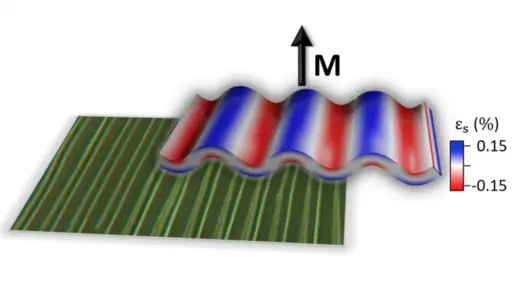In 1903, German mining engineer and chemist Carl Ludwig David Friedrich Heusler published the first description of the class of intermetallic alloys that bear his name. Today, he likely would be thrilled at how important those alloys may become in 21st-century computing.
Heusler compounds, which have highly tunable magnetic and electronic properties, have the potential to enable unique types of electronic devices with functionality beyond silicon-based transistors. Engineers at the University of Wisconsin-Madison have discovered a new technique for inducing magnetism in those promising materials.
The researchers have produced a free-standing membrane of the Heusler compound gadolinium-platinum-antimony. By mechanically straining it, they can induce magnetism in the thin membrane. The technique is detailed in a paper in May 3, 2021 issue of the journal Nature Communications.
“We knew this material had a similar crystal structure and composition as those exhibiting interesting magnetic, topological, and ferroelectric properties,” says Jason Kawasaki, an assistant professor of materials science and engineering at UW-Madison who led the research. “Our expectation was that with just a little kick, in the form of strain, we could induce magnetic ordering. But traditional methods for applying strain to crystals and thin films are quite limited.”
 PhD student Dongxue Du
PhD student Dongxue Du
That’s why he and his collaborators decided to try the new technique. Researchers are looking beyond silicon to new classes of materials with different properties, including magnetism, to advance the next generation of computing. Much of that research is focused on thin films, which are layers of crystalline materials just a few nanometers thick.
In general, researchers deposit these materials on a crystalline substrate, through a process called thin-film epitaxy. In most cases, the thin films bond with the rigid substrate, making it difficult to mechanically strain them by bending or stretching. In order to produce a free-standing Heusler compound that could be stressed, Kawasaki and his team turned to a technique that relies on the two-dimensional material graphene.
In short, the researchers made a material sandwich, then deconstructed it. Collaborator Michael Arnold, a professor of materials science and engineering, synthesized a layer of high-quality graphene. Kawasaki’s group transferred it onto an aluminum oxide (sapphire) substrate and then used epitaxy to deposit the gadolinium-platinum-antimony Heusler compound over the graphene. While the graphene allowed the Heusler compound to interact with the sapphire and form a thin-film crystalline structure, it also allowed the team to peel the compound off the substrate, creating a free-standing membrane.
As a result, the researchers could strain the membrane—in this case, by bending it, inducing ripples in the material. By manipulating the size of the ripples, they could adjust the magnetic properties of the membrane.
 Microscope image of rippled GdPtSb membrane on polyimide tape overlaid with a cartoon of simulated strain distribution in rippled membranes. Credit: Dongxue Du.
Microscope image of rippled GdPtSb membrane on polyimide tape overlaid with a cartoon of simulated strain distribution in rippled membranes. Credit: Dongxue Du.
In the future, they would like to fine-tune the process. “It’s hard to control the graphene quality, and we are still looking for better ways to grow crystalline graphene with a single orientation,” says PhD student and first author Dongxue Du. “Also, we can optimize the growth and quality of the film so we have more accurate control of the ripple height.”
One future hope is that this Heusler membrane, or another variation, could replace silicon semiconductors in random access memory (RAM), the high-speed, short-term memory in computers. Currently, RAM is volatile, meaning it loses all information when the power is turned off. However, using a ferromagnetic or ferroelectric material like a Heusler compound would make RAM much more energy-efficient, faster and non-volatile, meaning data could be stored even when the electricity is off.
“There are many applications we can envision because these compounds exhibit a delicate balance of competing interactions. With just a small kick, in the form of strain, we can tip that balance to induce dramatic changes in properties,” says Kawasaki. “The fundamental challenges are in growing these materials with the requisite atomic-scale precision.”
Jason Kawasaki is the Harvey D. Spangler Assistant Professor of Engineering. Michael Arnold is Beckwith-Bascom Professor. Other UW-Madison authors include Dongxue Du, Sebastian Manzo, Chenyu Zhang, Vivek Saraswat and Beckwith-Bascom Professor Paul Voyles.
Konrad Genser and Karin Rabe of Rutgers University also contributed to the paper.
The team at UW-Madison acknowledges support from the Army Research Office (Award number W911NF-17-1-0254), the National Science Foundation (DMR-1752797), US Department of Energy, Basic Energy Sciences (DE-FG02-08ER46547; DE-SC0016007) and Wisconsin MRSEC (DMR-1720415).